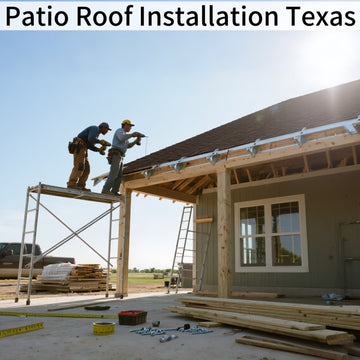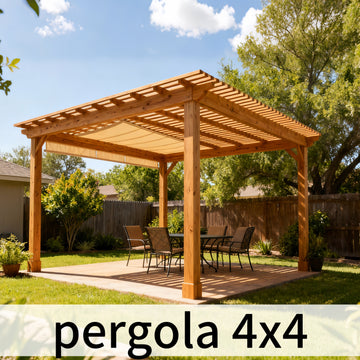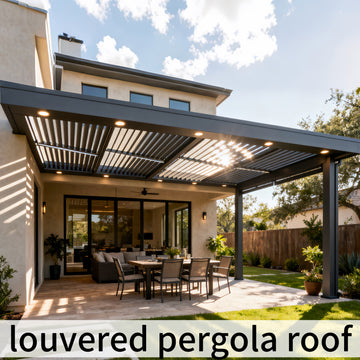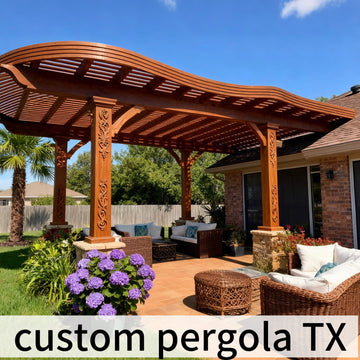In the Lone Star State, where the sun shines bright and outdoor living is a way of life, a patio roof can be a game-changer for your home. Whether you're looking to add some shade, enhance your home's aesthetic, or create a more comfortable outdoor entertaining area, understanding the ins and outs of patio roof installation is key. At paradisedecor-tx.com, we've got you covered.
How to Install a Patio Roof in Texas
Before you roll up your sleeves, there are a few crucial steps. First, check local building codes in Texas. Each city or county might have specific regulations regarding the size, height, and materials allowed for patio roofs. For example, in hurricane - prone coastal areas, roofs need to meet higher wind - resistance standards. Measure your patio area precisely. Texas homes often have spacious patios, and an accurate measurement ensures your roof fits perfectly. You'll also need to assess the existing structure where the roof will attach, like your home's fascia or walls.
Best Materials for Patio Roof Installation in Texas
Texas has a diverse climate, from the hot and humid Gulf Coast to the dry heat of West Texas. Wood, such as cedar or redwood, offers a classic, warm look. However, in humid areas, it requires regular maintenance to prevent rot and insect damage. Aluminum is a popular choice. It's lightweight, durable, and rust - resistant, making it suitable for all of Texas. Vinyl is another option, being low - maintenance and cost - effective. For areas with intense sunlight, like El Paso, materials with good heat - reflecting properties are ideal to keep the patio cool.
DIY Patio Roof Installation Guide in Texas
DIY installation can be rewarding, but it's not for the faint - hearted. Start by gathering all the necessary tools, like a circular saw, drill, and level. Follow a detailed plan. If you're installing a simple flat - roofed patio cover, begin by building the frame according to your measurements. In Texas, make sure to slope the roof slightly for proper drainage, as heavy rain showers can be common. Secure the frame to the existing structure using appropriate fasteners. However, if you're unsure about any step, especially when dealing with load - bearing aspects, it might be wise to consult a professional.
Types of Patio Roof Designs for Installation in Texas
Texas homes come in a variety of architectural styles, from Spanish - influenced haciendas in South Texas to modern ranch - style homes. A gabled roof can add a traditional, elegant touch and is great for shedding rain and snow in the rare colder months. A flat roof, on the other hand, is more contemporary and suits modern homes. Pergola - style roofs, with their open - lattice design, are perfect for those who want some shade while still enjoying the outdoors. In areas with beautiful views, like the Hill Country, a partially open - slatted roof can allow you to take in the scenery while providing some protection from the sun.
Steps for Installing a Wooden Patio Roof in Texas
If you've chosen wood for your patio roof, first treat the lumber to protect it from the elements. In Texas, the sun's UV rays and humidity can quickly damage untreated wood. Build the frame using sturdy beams, ensuring all joints are properly fastened. When installing the rafters, space them evenly according to the load - bearing requirements. In high - wind areas, additional bracing might be needed. Finish by adding the roofing material, such as wooden shingles or metal panels if you want a combination look.
Patio Roof Installation Contractors Near Me in Texas
Finding a reliable contractor is essential. Look for contractors with experience in Texas - specific installations. Check their reviews and ask for references. A good contractor will be familiar with local building codes and can handle any unforeseen issues that might arise during installation. They'll also ensure that your patio roof is installed safely and to a high standard, giving you peace of mind.
Maintenance Tips after Patio Roof Installation in Texas
After installation, maintenance is key. For metal roofs, check for any signs of rust, especially in coastal areas with salty air. Wood roofs need regular staining or painting to protect the wood. Clean the roof regularly to remove debris that could cause water pooling. In Texas, where storms can bring in a lot of leaves and twigs, this is particularly important. Inspect the fasteners and joints periodically to make sure they're still secure.
Safety Precautions for Patio Roof Installation in Texas
Safety should always be a top priority. When working at heights, use proper safety equipment like harnesses and ladders. In Texas, be aware of the weather. Sudden thunderstorms can roll in quickly, so avoid working during inclement weather. If you're using power tools, follow all safety guidelines. When installing the roof near power lines, make sure to keep a safe distance or have the power temporarily turned off.
A patio roof can truly transform your Texas outdoor space. Whether you choose to go the DIY route or hire a professional, understanding these aspects of patio roof installation will help you create the perfect outdoor retreat for your home.





